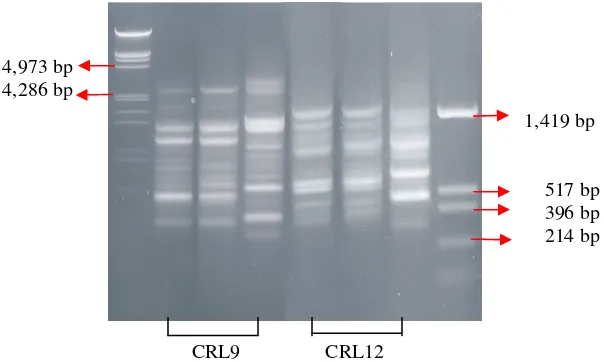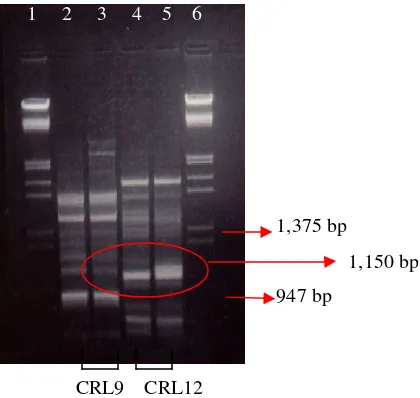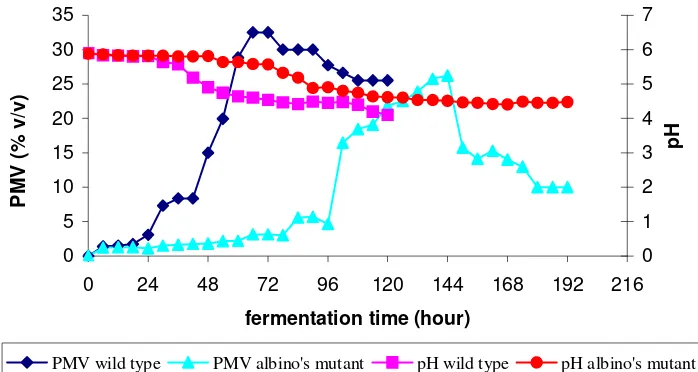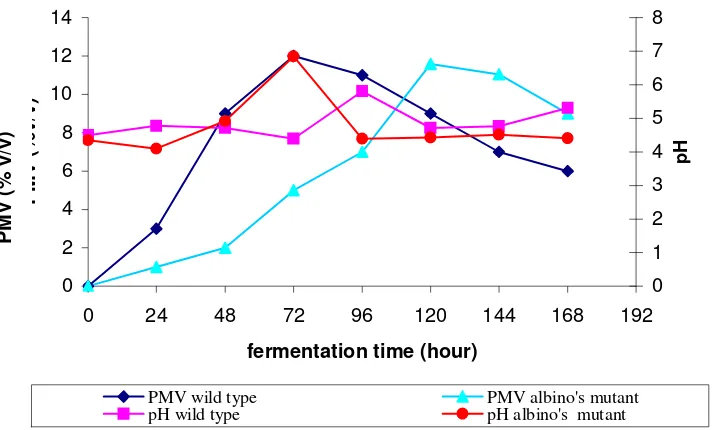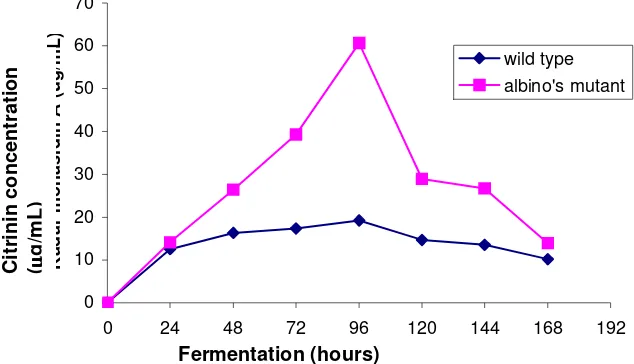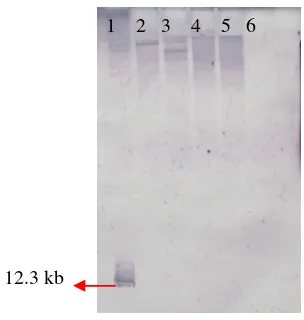AGROBACTERIUM TUMEFACIENS-MEDIATED GENETIC TRANSFORMATION OF MONASCUS PURPUREUS ALBINO MUTANT
Tiana Milanda1) , Syarif Hamdani2)
Marlia S. Wibowo3), Tutus Gusdinar3), Haryanto Dhanutirto3), Philippe J. Blanc4)
1)
Faculty of Pharmacy, Padjadjaran University, Indonesia 2)
Indonesian School of Pharmacy, Indonesia 3) School of Pharmacy, Institut Teknologi Bandung, Indonesia 4)
Institut National des Sciences Appliquées de Toulouse, France
ABSTRACT
Monascus purpureus ITBCC-HD-F002, an EMS-induced albino strain, was transformed into hygromycin B resistance using the hygromycin B phosphotransferase (hph) of Escherichia coli as the selective trait, governed by gdp promoter of Aspergillus nidulans in pUR5750 plasmid or CaMV35S promoter in pCAMBIA1304 plasmid. These plasmids were transformed into protoplasts and spores from this fungus mediated by A. tumefaciens LBA1100 and A. tumefaciens AGL1. The transformation efficiency achieved with pUR5750 mediated by A. tumefaciens LBA11 was 346 ± 4.00 transformants/107 protoplast, with pUR5750 mediated by A. tumefaciens AGL1 was 635.7 ± 13.32 transformants/107 spores and with pCAMBIA1304 mediated by A. tumefaciens AGL1 was 650.3 ± 10.02 transformants/107 spores. This result indicating the highly virulent strain A. tumefaciens AGL1 was found to be more efficient in DNA transfer than A. tumefaciens LBA1100 and the CaMV35S promoter from pCAMBIA1304 worked well in this fungus. The majority of transformants were mitotically stable up to five generations (92-96 %). The presence of the hph genes were detected by PCR. In four randomly chosen transformants, single-copy integration of the marker gene at different chromosomal site were proven by Southern Blot analysis. It favoured single-copy integration in genome, which facilitate genomic study using this method and as a tool for insertional mutagenesis for a mycotoxin gene disruption.. The additional marker in pCAMBIA1304 might serve for physiological study on another metabolite-targeting in this fungus, like natural pigments, antihypercholesterolemia, inflammatory and antitumour agents.
Introduction
Monascus purpureus is a red fungus that produces various secondary metabolites,
such as pigments, monacolin K, and citrinin. The pigments are traditionally used as food
and cosmetic colorants, whereas monacolin K shows an antihypercholesterolemic
activity. Citrinin shows an antimicrobial activity against Gram positive bacteria, but it
has carcinogenic, teratogenic and nephrotoxic properties (Blanc et al., 1998; Lakrod et
al., 2000). Many researches have been done to eliminate this toxic metabolite from
Monascus products. Since citrinin precursor is similar to its pigments, their biosynthesis
might be manipulated by the genetic engineering method. However, this method requires
comprehensive information about genetic transformation in M. purpureus (Blanc et al.,
1998a; Hajjaj et al., 1999). The optimal conditions found for efficient transformation of
certain Monascus could not be applied to another Monascus strain (Campoy et al., 2003).
This research was aimed to develop an efficient genetic transformation system
that can be used to eventually identify genes involved in M. purpureus pigments
production. To identify these genes, the transformation must be applied in a
nonproducing pigment mutant, called albino mutant, as a host cell obtained from M.
purpureus local strain. The systems employing hph gene in pUR5750 and
pCAMBIA1304, conferred resistance transformants cell to hygromycin B. These
markers were transformed into the host cells by Agrobacterium tumefaciens mediated
DNA transfer.
The wild-type M. purpureus ITBCC-HD-F001 isolated from Cikapundung
river-Bandung was firstly confirmed as M. purpureus using Random Amplification
Polymorphic DNA (RAPD) method. The fungus was subjected to mutation to obtain an
albino mutant by using a mutagenic agent ethyl methanesulfonate (EMS). Stability of the
mutant was assayed by rho-petite method, color consistency and mutant stability tests.
Genetic changes of the mutant was analyzed by the RAPD. The characteristics of the
albino were identified, including growth curve, biomass production curve and citrinin
production curve. The minimum inhibitory concentration of hygromycin B for albino
mutant were determined.
The pUR5750 and pCAMBIA1304 transformed into the albino mutant protoplasts
presence of the hph gene in the transformants genome were detected by Polymerase
Chain Reactions (PCR) method and Southern Blot analysis. A comparative study was
carried out to obtain the most efficient genetic transformation system for M. purpureus
ITBCC-HD-F001.
Materials and methods Strains and culture conditions
M. purpureus ITBCC-HD-F001 (School of Pharmacy ITB, Indonesia) was a high
pigment producer strain isolated from Cikapundung-river Bandung. As reference
strains, M. purpureus CECT2955T (Universidad de Valencia, Spain) and M. ruber
DSM1561 (Pusat Penelitian Bioteknologi LIPI Cibinong, Indonesia) were used. All
fungal strains were maintained on YMP agar slant (0.3 % yeast extract, 0.3 % malt
extract, 0.6 % peptone, 2.0 % glucose and 1.5 % bacto-agar) for 7-10 days at 28°C. The
spores were collected using sterile aquadest and were used to inoculate liquid cultures in
YMP broth.
To achieve Agrobacterium-mediated DNA transfer experiments, A. tumefaciens
LBA1100 (Instituto de Biotechnologia de Leon, Spain) and the highly virulent strain A.
tumefaciens AGL1 (Pusat Penelitian Bioteknologi LIPI Cibinong, Indonesia) were used.
Agrobacterium strains were grown in LB agar or LB broth (sodium chloride 0.8%,
tryptone 1%, yeast extract 0.5%, pH 7.0) supplemented with kanamycin (100 µg/mL).
Plasmids
The plasmids used in this research were :
1. pUR5750 (15 kb), an E. coli-Agrobacterium binary vector containing E. coli hph
gene inserted between the gdp promoter and the trpC terminator sequence from A.
nidulans flanked by the left and right borders of T-DNA (kindly provided by S.
Campoy, Instituto de Biotechnologia de Leon, Spain).
2. pCAMBIA1304 (12.3 kb), an E. coli-Agrobacterium binary vector containing E. coli
hph gene inserted between the CaMV35S promoter and CaMV35S polyA signal
Confirmation of the fungus as M. purpureus by RAPD method
The confirmation procedure applied is based on the protocol described by Campoy et al. (2003)
for M. purpureus IBCC1. Liquid cultures of M. purpureus ITBCC-HD-F001 and its reference strains were
incubated at 28°C on a rotary shaker at 200 rpm for 20 hours. Mycelial masses were harvested by
centrifugation at 12,000 rpm for 10 min. Total DNA from these strains were extracted using Wizard
Genomic DNA Purification Kit (Promega). DNA concentration was determined by spectrophotometric
method. RAPD reactions were performed using 0.5 µL 20 pmol/µL CRL9 (5’-CAGCCGCCCC-3’) or 0.5
µL 20 pmol/µL CRL12 (5’-CGCCGCCCG-3’), 3.6 µL 25 mM magnesium chloride, 0.25 µL 20 mM
dNTP, 0.2 µL 50 U/µL Taq DNA polymerase, 2.5 µL Taq polymerase buffer 10 x and aquabidest until 25
µL total volume. The PCR program was as follows : an initial denaturating step of 4 min at 94°C, followed
by 44 cycles of 40 s denaturation at 94°C, 1 min annealing at 34°C and 2 min polymerization at 72°C.
RAPD products were electrophoretically separated in 1.5 % agarose in TAE 1X.
Mutation of M. purpureus ITBCC-HD-F001 by ethyl methanesulfonate (EMS)
The mutation procedure applied is based on the protocol described by Susilowati
et al. (1997) for Saccharomyces cerevisiae. Liquid cultures of M. purpureus
ITBCC-HD-F001 were incubated at 28°C on a rotary shaker at 200 rpm for 20 hours. About 10 mL of
cultures was concentrated by centrifugation at 12,000 rpm for 10 min at 4°C and
resuspended in 10 mL 0.2 M phosphate buffer pH 7.0. One mL of this suspension was
incubated in a solution containing 100 µ L 2 % glucose and various volume of 0.2 M
phosphate buffer pH 7.0 and EMS to get 0, 1.5, 2.0, 2.5, and 3.0 % v/v EMS
concentration. The mixtures were incubated at 28°C on a rotary shaker at 150 rpm for 90
min. The treatment was stopped by the addition of 2 mL 5 % sodium thiosulphate and
incubated at 28°C on a rotary shaker at 150 rpm for 20 min. The suspensions were
concentrated by centrifugation at 12,000 rpm for 10 min at 4°C and resuspended in 1 mL
0.2 M phosphate buffer pH 7.0. The suspension was then transferred to YMP agar and
incubated for 7-14 days at 28°C. Red and white colonies were counted to determine
mutant viability and mutant efficiency.
Stability of the mutant was assayed by rho-petite method, color consistency and
mutant stability tests. The white colonies were transferred to YMP-Gli agar (YMP agar
with 3 % v/v glycerine) for rho-petite test. The stable white colonies from YMP-Gli agar
Further, the stable white colonies were subcultured on YMP agar until five generations
for mutant stability test.
Genetics analysis of albino mutant by RAPD method
Genetic changes of the albino mutant was analyzed using RAPD by the same
procedure with confirmation of the wild-type. The wild-type M. purpureus
ITBCC-HD-F001 was used as a reference strain.
Characterization of albino mutant
The mutant characterization applied is based on the protocol described by Blanc
et al. (1995) for M. purpureus NRRL1406 and Kareri et al. (2004) for M. purpureus
ITBCC-HD-F001. The characteristics of the albino included growth curve, biomass
production curve and citrinin production curve. Series of 500-mL shake flasks with 95
mL YMP broth were inoculated with 5 mL of spore suspension from the albino mutant
and its parent strain. The cultures were maintained at 28°C on a rotary shaker at 200 rpm
until the death phase was reached. About 10 mL sample of the cultures were picked up
every 6 hours. Packed Mycelia Volume (PMV) % v/v of the cultures was obtained by
centrifuged the samples at 4,000 rpm for 10 min. From the supernatant, pH was measured
by pHmeter. The PMV and pH data’s were plotted to a growth curve. The optimum
inoculum was determined and growth rate of the cultures was calculated.
Series of 500-mL shake flasks with 95 mL YMP broth were inoculated with 5 mL
of the optimum inoculums from the albino mutant and its parent strain. The cultures were
maintained at 28°C on a rotary shaker at 200 rpm until the death phase was reached.
About 10 mL sample of the cultures was picked up every 24 hours. The PMV and pH
data’s were plotted to a biomass production curve. The biomass production rate of the
cultures was calculated.
The samples from the cultures were extracted by acetonitrile until three times.
The filtered extract was twice defatted with isooctane. After adding an equal volume of
water and acidification to pH 4.5 with sulphuric acid (50 : 50 v/v), the extract was
partitioned with chloroform. The lower phase was evaporated to dryness, it was then
to citrinin production curve. The specific citrinin production rate of the cultures was
calculated from the rate of increase in concentration of citrinin in logarithmic phase.
Determination of MIC hygromycin B
The albino mutant was grown on YMP agar containing hygromycin B (0, 2, 4, 6,
8 and 10 µg/mL) at 280C for 7-14 days. The fungus growth was observed to obtain the
culture which was still grown on certain concentration of hygromycin B.
Transformation pUR5750 and pCAMBIA1304 to the albino mutant protoplast and spores
by A. tumefaciens mediated DNA transfer
The transformation procedure applied is based on the protocol described by Sun et
al. (2002), Campoy et al. (2003) and Sugui et al. (2003). A. tumefaciens LBA1100 was
grown on 48 hours in LB agar containing 100 µg/mL kanamycin. The spores were
collected using sterile aquadest and were used to inoculate 10 mL LB broth containing
100 µg/mL kanamycin. Liquid cultures were incubated at 28°C on a rotary shaker at 200
rpm for 12 hours. A part of the cultures were inoculated into 10 mL induction medium
(LB broth supplemented 200 µM acetosyringone) until an optical density at 600 nm of
0.2 was reached. They were incubated on a rotary shaker at 200 rpm for 5-6 hours or until
an optical density at 600 nm of 0.8 (approximately 108 cells) was reached.
Spore of the albino strain were obtained by growing this fungus strain on YMP
agar for 12-14 days at 28°C, followed by collecting spores using sterile aquadest. The
total number of spores was determined by hemacytometer. A part of spores suspension
was used to preparing the protoplasts as previously described. The total number of
protoplasts was determined by hemacytometer.
Co-cultivation between A. tumefaciens and albino mutant were performed as
follows : 100 µL containing approximately 107 spores were mixed with 100 µL of the A.
tumefaciens culture and plated onto sterile nylon membrane (Roche-Applied Science) or
cellulose membrane (Whatman No. 1 filter paper). These membranes were then
incubated at 22-25°C or 26-28°C for 72 hours on induction medium (YMP agar
containing 200 µM acetosyringone) for induction of the vir genes. Following incubation,
(YMP agar containing 50 µg/mL higromycin B and 200 µM cefotaxim to inhibit the
growth of A. tumefaciens). Further, the pUR5750 and pCAMBIA1304 was transformed
into the albino mutant spores mediated by A. tumefaciens AGL1.
About 50 transformants were tested for stability by replating the transformants 4
times (4 generations). The fifth generation stability was tested by growing this
transformant on selection medium (YMP agar containing 200 µg/mL hygromycin B) and
non selection medium (YMP agar).
PCR analysis for detection of the hph gene in putative transformants was
performed using primer pair hphF (5’ TTCGATGTAGGAGGGCGTGGAT 3’) and
hphDR (5’ CGCGTCTGCT GCTCCATACAAG 3’), a primer combination obtained by
DNAStar program. PCR amplification included an initial denaturating step of 4 min at
95oC, followed by 35 cycles of 45 s denaturation (94oC), 1 min annealing (60oC) and 1.5
min polymerization (72oC).
Southern Blot analysis
Southern Blot analysis was carried out as described by Sambrook et al. (1989)
with 5 µg DNA in each sample. DNA probes (pCAMBIA1304/HindIII) were labeled by
random primer method using DIG High Prime DNA Labeling and Detection Starter Kit I
(Roche Applied-Science), following the instructions of the manufacturer.
Results and Discussion
Confirmation of the fungus as M. purpureus by RAPD
The wild-type M. purpureus ITBCC-HD-F001 isolated from Cikapundung
river-Bandung was confirmed as M. purpureus using Random Amplification Polymorphic
DNA (RAPD) method. Identical bands were observed in M. purpureus ITBCC-HD-F001
and M. purpureus CECT2955T (Figure 1.), but these bands were different from those of
M. ruber DSM1561. These results indicated that the strain used in this work was M.
purpureus.
0 20 40 60 80 100 120
0 0.5 1 1.5 2 2.5 3 3.5
Konsentrasi EMS (%)
V ia b il it a s m u ta n ( % )
Figure 1. RAPD amplification of Monascus spesies DNA using CRL9 and CRL12
(1) DNA marker λ/HindIII /EcoRI (2, 5)M. purpureus ITBCC-HD-F001
(3, 6)M. purpureus CECT2955T (4, 7)M. ruber DSM1561 (8) DNA marker pUC19/HinfI
Mutation of M. purpureus ITBCC-HD-F001 by EMS
The fungus was subjected to mutation to obtain an albino mutant by using various
concentrations of EMS (1.0, 1.5, 2.0, 2.5, and 3.0 % v/v) for 90 minutes. The death curve
of M. purpureus ITBCC-HD-F001 was presented in Figure 2.
Figure 2. The death curve of M. purpureus ITBCC-HD-F001 that mutated by various concentration of EMS for 90 minutes
1,419 bp 517 bp 396 bp 214 bp 4,973 bp 4,286 bp
CRL9 CRL12
M u ta n t v ia b il it y ( % )
About 1.93 x 103 white colonies were obtained using 2.5 % v/v EMS with 6.01%
mutant viability and 1.08 % mutation efficiency. From these results, we know that an
albino mutant can be obtained from M. purpureus ITBCC-HD-F001 using 2.5 % v/v
EMS for 90 minutes.
The stability of the mutant was analyzed by rho petite method, color consistency
and mutant stability tests. From the results of these tests, we know that the mutant was
mutated on choromosomes, consistent in color and stable for five generations. This
mutant called M. purpureus ITBCC-HD-F002 or albino mutant.
Genetics analysis of albino mutant by RAPD
DNAs from the albino mutant and its parent strains were compared by RAPD
(Figure 3.). One of the RAPD’s bands of this mutant at 1,150 bp was considered as a
genetic change caused by EMS treatment.
Figure 3. RAPD amplification of Monascus spesies DNA using CRL9 and CRL12
(1) DNAmarker λ/HindIII/EcoRI (2, 4)M. purpureus ITBCC-HD-F001
(3, 5)M. purpureus ITBCC-HD-F002 (6) DNA marker pUC19/HinfI
Characterization of albino mutant
Growth of albino mutant was compared to its parent strain. The growth curve
from the wild-type and the albino mutant were presented in Figure 4. 1 2 3 4 5 6
1,150 bp 1,375 bp
947 bp
Figure 4. The growth curve from albino mutant and the wild-type
The growth rate of albino mutant (0.182 % v/v per hour) was significantly slower
than its parent strain (0.492 % v/v per hour) under the same culture conditions. The peak
of this curve shifted from 66 hours (for the wild type) to 144 hours (for the mutant). pH
in the broth from the wild-type decreased more rapidly at an early stage of the
fermentation. Optimum inoculums that used for fermentation production was removed
from 64 hours (for the wild type) to 102 hours (for the mutant).
The biomass production curve from the wild-type and albino mutant were
presented in Figure 5. 0
5 10 15 20 25 30 35
0 24 48 72 96 120 144 168 192 216
fermentation time (hour)
P
M
V
(
%
v
/v
)
0 1 2 3 4 5 6 7
p
H
PMV wild type PMV albino's mutant pH wild type pH albino's mutant
P
M
V
(
%
v
/v
0 2 4 6 8 10 12 14
0 24 48 72 96 120 144 168 192
fermentation time (hour)
P M V ( % v /v ) 0 1 2 3 4 5 6 7 8 p H
PMV wild type PMV albino's mutant pH wild type pH albino's mutant
Figure 5. Biomass production curve from the wild-type and the albino mutant
The biomass production rate from the albino mutant (0.097 % v/v per hour) was
significantly slower than its parent strain (0.167 % v/v per hour) under the same culture
conditions. The maximum biomass production from the mutant (11.58 % v/v ) was
observed 120 hours after the initiation of the fermentation, whereas the wild type (12 %
v/v) was observed at 72 hours. pH from both of the strains fluctuated during the
fermentation process.
The citrinin production curve from the wild-type and albino mutant were
presented in Figure 6. The citrinin production rate from the albino mutant (0.632 µg/mL
per hour) was significantly faster than its parent strain (0.200 µg/mL per hour) under
the same culture conditions. The maximum biomass production from the mutant (60.71
µg/mL) and from the wild-type (19.19 µg/mL) was observed 96 hours after the initiation
of the fermentation. That is possible because the pigments precursor is similar to citrinin.
The mutation of the genes involved in pigments production caused precursor
accumulation, which was used to produce citrinin.
0 10 20 30 40 50 60 70
0 24 48 72 96 120 144 168 192
Waktu fermentasi (jam)
K a d a r m o n a s id in A ( u g /m L ) wild type albino's mutant
Figure 6. Citrinin production curve from the wild-type and the albino mutant
Determination of MIC hygromycin B
M. purpureus ITBCC-HD-F002 is very sensitive to hygromycin B, being unable to
grow in plates supplemented with 4 µg/mL hygromycin B. This strain is more sensitive
to these antibiotics than the other M. purpureus strain (Campoy et al., 2003). This was
considered suitable for the selection of resistant colonies in transformation experiments.
The transformants were selected for their ability to grown in the presence of 50 µg/mL
hygromycin B.
Transformation pUR5750 and pCAMBIA1304 to the albino mutant protoplasts and
spores by A. tumefaciens mediated DNA transfer
The pUR5750 was transformed into the albino mutant protoplasts and spores
mediated by A. tumefaciens LBA1100. Protoplasts and Agrobacterium were cocultivated
at a ratio of 1:10 (protoplast to bacteria), because this condition resulted in high
frequencies of transformants in Aspergillus fumigatus (Sugui et al., 2005). Two different
membranes (cellulose/Whatman No.1 paper filter and nylon membrane) were tested as
substrate for cocultivation of M. purpureus and Agrobacterium cell, because the best
results for A. fumigatus were obtained with these membranes (Sugui et al., 2005). The
protoplasts and Agrobacterium were cocultivated at 22-25°C or 26-28°C, because these
temperature range applied frequently in several transformation systems for filamentous
fungus (Bundock et al., 1995; Chen et al., 2000; Malonek and Meinhardt, 2001; Sun et
al., 2002; Sugui et al., 2005; Pardo et al., 2005).
The transformation process resulted in 346 ± 400 hygromycin resistant
transformants per 107 protoplasts. The maximum of transformation efficiency was 350
transformants per 107 protoplasts. This transformant only appeared with protoplast as
host cell, probably because the bacterial strain used is a slightly virulent bacteria. The
transformation results indicate that the nylon membrane is not as efficient as cellulose
membrane. The reason for this difference is unclear. It is possible that the chemical
properties of this membrane may affect the distributon of protoplasts and Agrobacterium
cells or inhibit their interaction (Sugui et al., 2005). Beside that, the transformants only
appear from cocultivation of the cells at 22-25°C. Although 28°C is optimal growth for
A. tumefaciens, this temperature was not appropriate for T-DNA transfer. It has been
proposed that the T-DNA transfer machinery is greatly affected by temperature (Sun et
al., 2002).
Further, the pUR5750 was transformed into the albino mutant spores mediated by
A. tumefaciens AGL1. In this experiment the highly virulent strain A. tumefaciens AGL1
was found to be more efficient in DNA transfer than A. tumefaciens LBA1100. The best
yield was 635.7 ± 13.32 hygromycin B resistant transformants per 107 spores. The
maximum of transformation efficiency was 647 transformants per spores. Additionally,
differences in the transformation efficiency depending on the particular promoter
expressing the hph gene (Campoy et al., 2003). To prove this statement, the
pCAMBIA1304 was transformed into the albino mutant spores mediated by A.
tumefaciens AGL1. The best yield was 650.3 ± 10.02 hygromycin B resistant per 107
spores. The maximum of transformation efficiency was 660 transformants per 107 spores.
This result indicating that the CaMV35S promoter functions in this fungus better than
gdp promoter from pUR5750.
To test the genetic stability of A. tumefaciens-mediated transformants, 50
hygromycin B resistent transformant from different transformation systems were allowed
to sporulate in selection medium containing 50 µg/mL hygromycin B. After going
resistant. For all the tested transformants from fifth generations, no difference in growth
on selection medium (even with 200 µg/mL hygromycin B) and non selection medium
was observed. The growth of putative transformants was unaffected, indicating the
efficient expression of hph gene.
The presence of hph gene in the transformants was analysed by PCR and it yielded
the expected size DNA fragment (600 bp) appeared in transformants (Figure 7).
Figure 7. PCR detection of hph gene from randomly chosen hygromycin B resistant transformants (1, 7) DNA marker λ/HindIII/EcoRI (2) pUR5750 as positive control (3) DNA from albino mutant as negative control (4) DNA from hygromycin B resistant transformant (pUR5750/LBA100) (5) DNA from hygromycin B resistant transformant (pUR5750/AGL1) (6) DNA from hygromycin B resistant transformant (pCAMBIA1304/AGL1)
The DNA from these transformants was isolated, digested with HindIII and
hybridized with a 12.3–kb pCAMBIA1304/HindIII DNA probe containing the hph gene.
Of the transformants, 100 % showed a single hybridization band. 600 bp
1 2 3 4 5 6 7
Figure 8. Southern Blot analysis of genomic DNA from randomly chosen
hygromycin B resistant transformants. Hybridization was performed using a pCAMBIA1304/HindIII as probe (1) pCAMBIA1304/HindIII as positive control (2) DNA from hygromycin B resistant transformant/HindIII (pUR5750/LBA1100) (3) DNA from hygromycin B resistant
transformants/HindIII (pUR5750/AGL1) (4-5) DNA from hygromycin B resistant transformant/HindIII (pCAMBIA1304 /AGL1) (6) DNA from albino mutant/HindIII as a negative control
A comparison of protoplast formation and Agrobacterium-mediated DNA transfer
in Monascus was made. The efficiency of Agrobacterium-mediated DNA transformation
in Monascus was higher than the optimized system for protoplast formation. From three
systems which used Agrobacterium mediated DNA transfer method,
pCAMBIA1304/hph/AGL1 system resulted in higher transformation efficiency than the
other systems. pCAMBIA1304 has seven restriction sites for DNA insertion more than
four restriction sites in pUR5750. Beside that, this plasmid has additional selection
marker (mgfp5:gusA:His fusion), which may serve for physiological studies on
metabolite targeting in this fungus. These fact make pCAMBIA1304/hph/AGL1 system
as a former system ideal to transform Monascus.
From all genetic transformation system applied in this research it was showed that
the most efficient genetic transformation system for M. purpureus ITBCC-HD-F001 is
the system employing hph gene marker in pCAMBIA1304, transformed into albino
mutant by A. tumefaciens AGL1. 1 2 3 4 5 6
Conclusions
1. M. purpureus ITBCC-HD-F002 was an albino mutant that mutated in chromosome,
consistant and stable. This mutant has one additional RAPD band that was
considered as a genetic change caused by EMS. This mutagenic agent caused
decreasing of growth and biomass production rate, but increased citrinin production
rate.
2. The albino mutant is very sensitive to hygromycin B, whereas a resistance gene from
these antibiotics (hph genes) are sufficiently expressed in this mutant for selection of
transformants.
3. pUR5750 and pCAMBIA1304 can transformed into the albino mutant protoplasts and
spores mediated by A. tumefaciens LBA1100 or AGL1.The highly virulent strain of A.
tumefaciens was found to be more efficient in DNA transfer than sligthly virulent
strain. Additionally, differences in the transformation efficiency depending on the
particular promoter expressing the hph gene.
4. The most efficient genetic transformation system for M. purpureus ITBCC-HD-F001
is the system employing hph gene marker in pCAMBIA1304, which transformed into
albino mutant by A. tumefaciens AGL1.
REFERENCES
Blanc, P.J., Loret, M.O., and Goma, G. (1995) : Production of Citrinin by Various Species of Monascus, Biotech. Let., 17 (7), 291-294.
Blanc, P.J., Hajjaj, H., Loret, M.O., and Goma, G. (1998) : Control of Production of Citrinin by Monascus, The Symposium on Monascus Culture and Applications, Toulouse, France.
Bundock, P., Dulk-Ras, A., Beijersbergen, A., and Hooykaas, P.J.J. (1995) : Trans-kingdom T-DNA Transfer from Agrobacterium tumefaciens to Saccharomyces cerevisiae, EMBO J., 14 (13), 3206-3214.
Chen, X., Stone, M., Schlagnhaufer, C., and Romaine, C.P. (2000) : A Fruiting Body Tissue Method for Efficient Agrobacterium-mediated Transformation of Agaricus bisporus, Appl. Envi. Microbiol., 66 (10), 4510-4513.
Hajjaj, H., Klaebe, A., Loret, M.O., Goma, G., Blanc, P.J., and Francois, J. (1999) : Biosynthesis Pathway of Citrinin in The Filamentous Fungi Monascus ruber as Revealed by 13C Nuclear Magnetic Resonance, Appl. Environ. Microbiol., 65(1), 311-314.
Lakrod, K, Chaisrisook, C., Yongsmith, B., and Skinner, D.Z. (2000) : RAPD Analysis of Genetic Variation within a Collection of Monascus spp. Isolated from Red Rice (Angkak) and Sofu, Mycol. Res., 104 (4), 403-408.
Malonek, S., and Meinhardt, F. (2001) : Agrobacterium tumefasciens-mediated Gene Transformation of The Phytopathogenic Ascomycete Calonectria morganii, Curr. Genet.40, 152-156.
Pardo, A.G., Kemppainen, M., Valdemoros, D., Duplessis, S., Martin, F., and Tagu, D. (2005) : T-DNA Transfer from Agrobacterium tumefaciens to The Ectomycorrhizal Fungus Pisolithus microcarpus, Revista Argentina de Microbiologia, 37, 69-72.
Sugui, J.A., Chang, Y.C., and Kwon-Chung, K.J. (2005) : Agrobacterium tumefasciens -mediated Transformation of Aspergillus fumigatus : an Efficient Tool for Insertional Mutagenesis and Targeted Gene Disruption, Appl. Envi. Microbiol.,
71 (4), 1798-1802.
Susilowati, P.E. (1997) : Isolasi and Karakterisasi Mutan Resesif Sal4 di Ragi Saccaromyces cereviceae, Tesis Magister Kimia, Institut Teknologi Bandung.
Sun, C.B., Kong, Q.L., and Xu, W.S. (2002) : Efficient Transformation of Penicillium chrysogenum mediated by Agrobacterium tumefasciens LBA4404 for Cloning of Vitreoscilla Haemoglobin Gene, Electronic J. Biotechnol, 5 (1),
